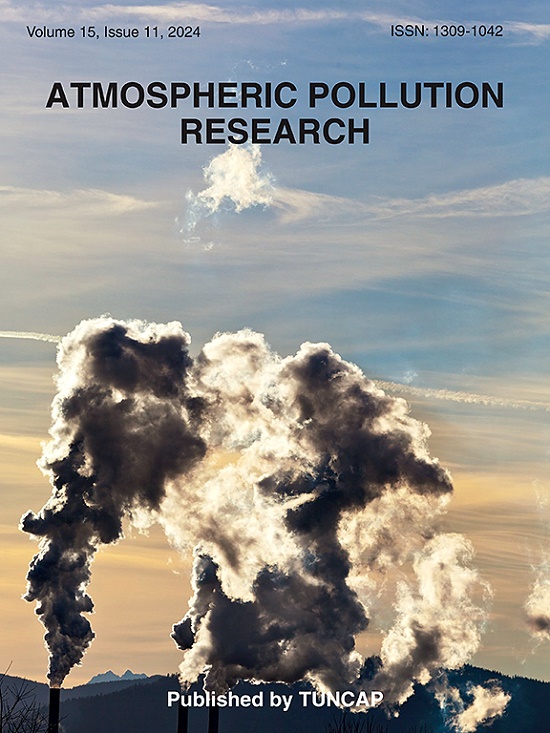Diesel generator exhaust emissions: Chemical characterization and cytotoxicity in bladder spheroids
IF 3.5
3区 环境科学与生态学
Q2 ENVIRONMENTAL SCIENCES
引用次数: 0
Abstract
Diesel generators, widely used in developing countries, compensating for long power outages and blackouts, are significant sources of air pollution. In this study, diesel exhaust particulate matter (DEPM) samples were collected from two midsize generators operating in Beirut by cascade impaction, and gravimetrically analyzed for size. The smallest fraction captured on quartz filter was then chemically characterized for its constituents, and examined for its cytotoxicity on 2D and 3D human uroepithelial cell cultures. Results showed that 87 % of collected PM are quasi-ultrafine (<0.33 μm in diameter), and marked high emissions of organic and elemental carbon (OC/EC), elements and metals, particularly Ca, Fe, S, Al, and Ti, and polyaromatic hydrocarbons (PAHs), mainly Benzo[g,h,i]perylene and Dibenzo[a,h]anthracene, as well as high emissions of dioxins, furans and polychlorinated biphenyls (PCBs), particularly OCDD, 1,2,3,4,6,7,8 HpCDF, and PCB118. In addition, in vitro testing showed decreased proliferation, viability, and spheroid formation ability only at high concentrations. In conclusion, DEPM from domestic generators consists of a wide panel of potent toxicants, notably genotoxic, carcinogenic, and endocrine disrupting compounds. Additionally, in vitro results provide a solid basis to further examine the potential contribution of DEPM to bladder tumorigenesis in established cell culture models.
柴油发电机废气排放:化学特性和膀胱球体的细胞毒性
柴油发电机在发展中国家广泛使用,用于补偿长期停电和停电,是空气污染的重要来源。在这项研究中,通过叶栅撞击收集了贝鲁特两台中型发电机的柴油机排气颗粒物(DEPM)样本,并对其大小进行了重力分析。在石英过滤器上捕获的最小部分,然后对其成分进行化学表征,并在2D和3D人类尿上皮细胞培养物上检测其细胞毒性。结果表明,87%的PM为准超细颗粒(直径0.33 μm),有机碳和元素碳(OC/EC)、元素和金属(Ca、Fe、S、Al和Ti)和多芳烃(PAHs)(主要是苯并[g,h,i]苝和二苯并[a,h]蒽)的高排放,二恶英、呋喃和多氯联苯(PCBs) (OCDD、1,2,3,4,6,7,8 HpCDF和PCB118)的高排放。此外,体外试验表明,只有在高浓度下,增殖、活力和球体形成能力才会下降。综上所述,家用发电机产生的DEPM含有广泛的强毒性物质,特别是遗传毒性、致癌性和内分泌干扰化合物。此外,体外实验结果为进一步研究DEPM在已建立的细胞培养模型中对膀胱肿瘤发生的潜在贡献提供了坚实的基础。
本文章由计算机程序翻译,如有差异,请以英文原文为准。
求助全文
约1分钟内获得全文
求助全文
来源期刊

Atmospheric Pollution Research
ENVIRONMENTAL SCIENCES-
CiteScore
8.30
自引率
6.70%
发文量
256
审稿时长
36 days
期刊介绍:
Atmospheric Pollution Research (APR) is an international journal designed for the publication of articles on air pollution. Papers should present novel experimental results, theory and modeling of air pollution on local, regional, or global scales. Areas covered are research on inorganic, organic, and persistent organic air pollutants, air quality monitoring, air quality management, atmospheric dispersion and transport, air-surface (soil, water, and vegetation) exchange of pollutants, dry and wet deposition, indoor air quality, exposure assessment, health effects, satellite measurements, natural emissions, atmospheric chemistry, greenhouse gases, and effects on climate change.
 求助内容:
求助内容: 应助结果提醒方式:
应助结果提醒方式:


